这期内容当中小编将会给大家带来有关Python中怎么使用使用Plotly实现数据可视化,文章内容丰富且以专业的角度为大家分析和叙述,阅读完这篇文章希望大家可以有所收获。
Plotly 是一个数据绘图库,具有整洁的接口,它旨在允许你构建自己的 API。
Plotly 是一个绘图生态系统,可以让你在 Python 以及 JavaScript 和 R 中进行绘图。在本文中,我将重点介绍使用 Python 库进行绘图。
Plotly 有三种不同的 Python API,你可以选择不同的方法来使用它:
类似于 Matplotlib 的面向对象的 API
数据驱动的 API,通过构造类似 JSON 的数据结构来定义绘图
类似于 Seaborn 的高级绘图接口,称为 “Plotly Express” API
我将通过使用每个 API 来绘制相同的图来探索它们:英国大选结果的分组柱状图。
在我们进一步探讨之前,请注意,你可能需要调整你的 Python 环境来让这段代码运行,包括以下内容:
运行最新版本的Python(Linux、Mac 和 Windows 的说明)
确认你运行的 Python 版本能与这些库一起工作
数据可在线获得,可以用 Pandas 导入。
import pandas as pddf = pd.read_csv('https://anvil.works/blog/img/plotting-in-python/uk-election-results.csv')现在我们可以继续进行了。
Plotly 面向对象的 API 被称为 graph_objects,它有点类似于 Matplotlib 的面向对象 API。
要创建一个柱状图,你可以构造一个包含四个柱状图的对象:
# 导入 Plotly 和数据import plotly.graph_objects as gofrom votes import wide as df # 得到 x 列表years = df['year']x = list(range(len(years))) # 定义绘图bar_plots = [ go.Bar(x=x, y=df['conservative'], name='Conservative', marker=go.bar.Marker(color='#0343df')), go.Bar(x=x, y=df['labour'], name='Labour', marker=go.bar.Marker(color='#e50000')), go.Bar(x=x, y=df['liberal'], name='Liberal', marker=go.bar.Marker(color='#ffff14')), go.Bar(x=x, y=df['others'], name='Others', marker=go.bar.Marker(color='#929591')),] # 指定样式layout = go.Layout( title=go.layout.Title(text="Election results", x=0.5), yaxis_title="Seats", xaxis_tickmode="array", xaxis_tickvals=list(range(27)), xaxis_ticktext=tuple(df['year'].values),) # 绘制柱状图fig = go.Figure(data=bar_plots, layout=layout) # 告诉 Plotly 去渲染fig.show()
与 Matplotlib 不同的是,你无需手动计算柱状图的 x 轴位置,Plotly 会帮你适配。
最终结果图:
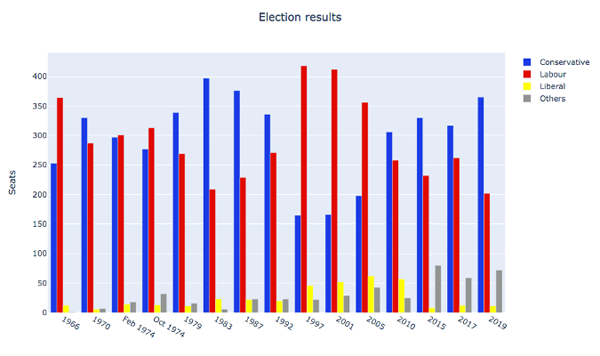
A multi-bar plot made using Graph Objects (© 2019 Anvil)
你还可以使用 Python 基本数据结构来定义绘图,它与面对对象 API 具有相同的结构。这直接对应于 Plotly 的 JavaScript 实现的 JSON API。
# 定义绘图数据fig = { 'data': [ {'type': 'bar', 'x': x, 'y': df['conservative'], 'name': 'Conservative', 'marker': {'color': '#0343df'}}, {'type': 'bar', 'x': x, 'y': df['labour'], 'name': 'Labour', 'marker': {'color': '#e50000'}}, {'type': 'bar', 'x': x, 'y': df['liberal'], 'name': 'Liberal', 'marker': {'color': '#ffff14'}}, {'type': 'bar', 'x': x, 'y': df['others'], 'name': 'Others', 'marker': {'color': '#929591'}}, ], 'layout': { 'title': {'text': 'Election results', 'x': 0.5}, 'yaxis': {'title': 'Seats'}, 'xaxis': { 'tickmode': 'array', 'tickvals': list(range(27)), 'ticktext': tuple(df['year'].values), } }} # 告诉 Plotly 去渲染它pio.show(fig)最终结果与上次完全相同:
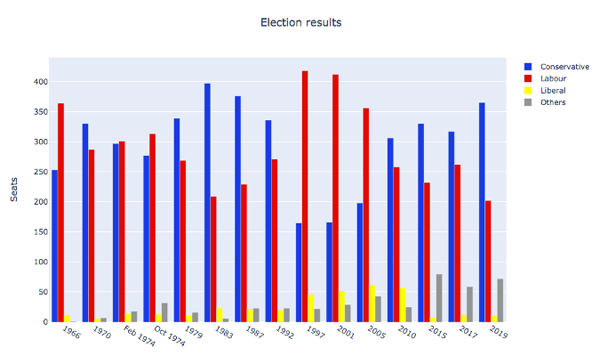
A multi-bar plot made using JSON-like data structures (© 2019 Anvil)
Plotly Express 是对图对象进行封装的高级 API。
你可以使用一行代码来绘制柱状图:
# 导入 Plotly 和数据import plotly.express as pxfrom votes import long as df # 定义颜色字典获得自定义栏颜色cmap = { 'Conservative': '#0343df', 'Labour': '#e50000', 'Liberal': '#ffff14', 'Others': '#929591',} # 生成图fig = px.bar(df, x="year", y="seats", color="party", barmode="group", color_discrete_map=cmap)这里使用了长表 数据,也称为“整洁数据”。这些列代表年份、政党和席位,而不是按政党划分。这与在 Seaborn 中制作柱状图非常相似。
>> print(long) year party seats0 1922 Conservative 3441 1923 Conservative 2582 1924 Conservative 4123 1929 Conservative 2604 1931 Conservative 470.. ... ... ...103 2005 Others 30104 2010 Others 29105 2015 Others 80106 2017 Others 59107 2019 Others 72 [108 rows x 3 columns]
你可以访问底层的图对象 API 进行详细调整。如添加标题和 y 轴标签:
# 使用图对象 API 来调整绘图import plotly.graph_objects as gofig.layout = go.Layout( title=go.layout.Title(text="Election results", x=0.5), yaxis_title="Seats",)
最后,让 Plotly 渲染:
fig.show()
这将在未使用的端口上运行一个临时 Web 服务器,并打开默认的 Web 浏览器来查看图像(Web 服务器将会马上被关闭)。
不幸的是,结果并不完美。x 轴被视为整数,因此两组之间的距离很远且很小,这使得我们很难看到趋势。
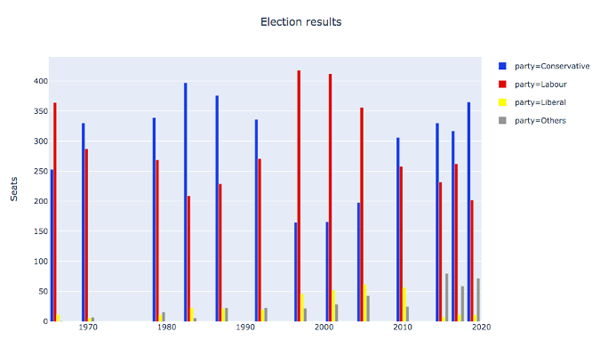
A multi-bar plot made using Plotly Express (© 2019 Anvil)
你可能会尝试通过将 x 值转换为字符串来使 Plotly Express 将其视为字符串,这样它就会以均匀的间隔和词法顺序来绘制。不幸的是,它们的间隔还是很大,像在 graph_objects中那样设置 xaxis_tickvals 也不行。
与 Seaborn 中的类似示例不同,在这种情况下,抽象似乎没有提供足够的应急方案来提供你想要的东西,但是也许你可以编写自己的 API?
对 Plotly 的操作方式不满意?那就构建自己的 Plotly API!
Plotly 的核心是一个 JavaScript 库,它使用 D3 和 stack.gl 进行绘图。JavaScript 库的接口使用指定的 JSON 结构来绘图。因此,你只需要输出 JavaScript 库喜欢使用的 JSON 结构就好了。
Anvil 这样做是为了创建一个完全在浏览器中工作的 Python Plotly API。
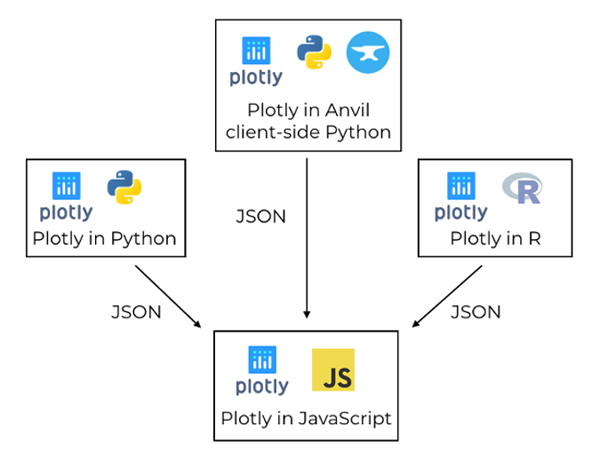
Plotly uses a JavaScript library to create plots, driven by libraries in other languages via JSON (© 2019 Anvil)
在 Anvil 版本中,你可以同时使用图对象 API 和上面介绍的 Python 数据结构方法。运行完全相同的命令,将数据和布局分配给 Anvil 应用程序中的 Plot 组件。
这是用 Anvil 的客户端 Python API 绘制的多列柱状图:
# 导入 Anvil 库from ._anvil_designer import EntrypointTemplatefrom anvil import *import anvil.server # 导入客户端 Plotlyimport plotly.graph_objs as go # 这是一个 Anvil 表单class Entrypoint(EntrypointTemplate): def __init__(self, **properties): # Set Form properties and Data Bindings. self.init_components(**properties) # 从服务器获取数据 data = anvil.server.call('get_election_data') # 获取一个方便的 x 值列表 years = data['year'] x = list(range(len(years))) # 定义绘图 bar_plots = [ go.Bar(x=x, y=data['conservative'], name='Conservative', marker=go.Marker(color='#0343df')), go.Bar(x=x, y=data['labour'], name='Labour', marker=go.Marker(color='#e50000')), go.Bar(x=x, y=data['liberal'], name='Liberal', marker=go.Marker(color='#ffff14')), go.Bar(x=x, y=data['others'], name='Others', marker=go.Marker(color='#929591')), ] # 规定布局 layout = { 'title': 'Election results', 'yaxis': {'title': 'Seats'}, 'xaxis': { 'tickmode': 'array', 'tickvals': list(range(27)), 'ticktext': data['year'], }, } # 生成多列柱状图 self.plot_1.data = bar_plots self.plot_1.layout = layout绘图逻辑与上面相同,但是它完全在 Web 浏览器中运行,绘图是由用户计算机上的 Plotly JavaScript 库完成的!与本系列的所有其它 Python 绘图库相比,这是一个很大的优势。因为其它 Python 库都需要在服务器上运行。
这是在 Anvil 应用中运行的交互式 Plotly 图:
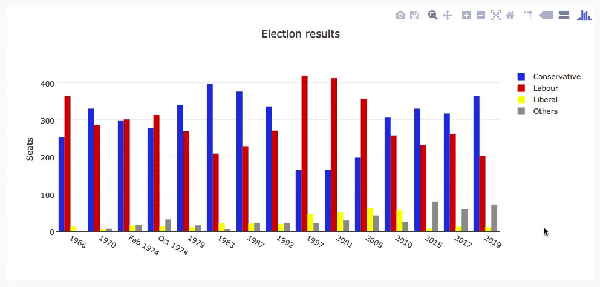
The election plot on the web using Anvil's client-side-Python Plotly library (© 2019 Anvil)
你可以复制此示例作为一个 Anvil 应用程序(注意:Anvil 需要注册才能使用)。
在前端运行 Plotly 还有另一个优势:它为自定义交互行为提供了更多选项。
Plotly 绘图不仅是动态的,你可以自定义它们的互动行为。例如,你可以在每个柱状图中使用 hovertemplate 自定义工具提示的格式:
go.Bar( x=x, y=df['others'], name='others', marker=go.bar.Marker(color='#929591'), hovertemplate='Seats: <b>%{y}</b>', ),当你把这个应用到每个柱状图时,你会看到以下结果:
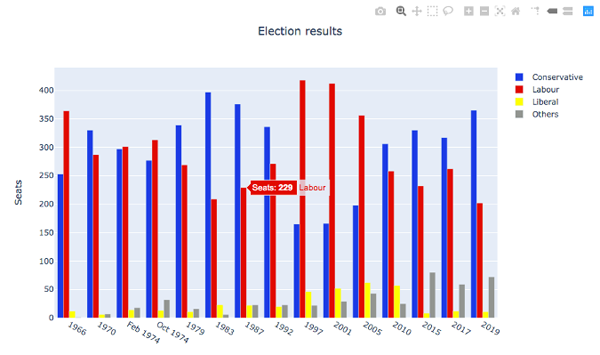
A multi-bar plot with custom tool-tips (© 2019 Anvil)
这很有用,当你想要在某些事件发生时执行任何你想要的代码就更好了(例如,当用户将鼠标悬停在栏上,你想要显示一个相关选举的信息框)。在 Anvil 的 Plotly 库中,你可以将事件处理程序绑定到诸如悬停之类的事件,这使得复杂的交互成为可能。
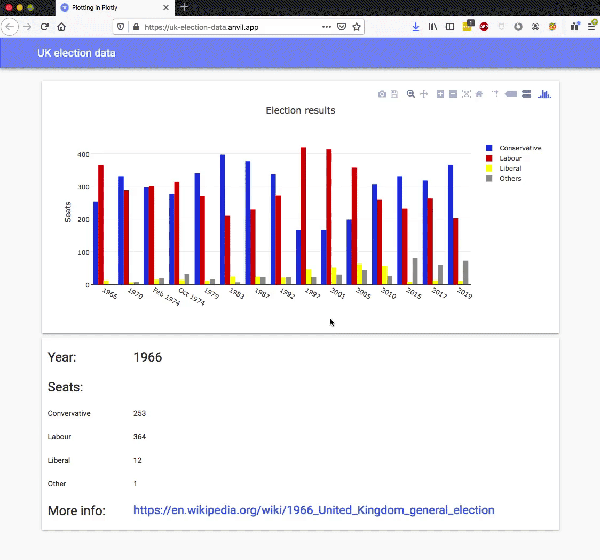
A multi-bar plot with a hover event handler (© 2019 Anvil)
你可以通过将方法绑定到绘图的悬停事件来实现:
def plot_1_hover(self, points, **event_args): """This method is called when a data point is hovered.""" i = points[0]['point_number'] self.label_year.text = self.data['year'][i] self.label_con.text = self.data['conservative'][i] self.label_lab.text = self.data['labour'][i] self.label_lib.text = self.data['liberal'][i] self.label_oth.text = self.data['others'][i] url = f"https://en.wikipedia.org/wiki/{self.data['year'][i]}_United_Kingdom_general_election" self.link_more_info.text = url self.link_more_info.url = url上述就是小编为大家分享的Python中怎么使用使用Plotly实现数据可视化了,如果刚好有类似的疑惑,不妨参照上述分析进行理解。如果想知道更多相关知识,欢迎关注亿速云行业资讯频道。
免责声明:本站发布的内容(图片、视频和文字)以原创、转载和分享为主,文章观点不代表本网站立场,如果涉及侵权请联系站长邮箱:is@yisu.com进行举报,并提供相关证据,一经查实,将立刻删除涉嫌侵权内容。